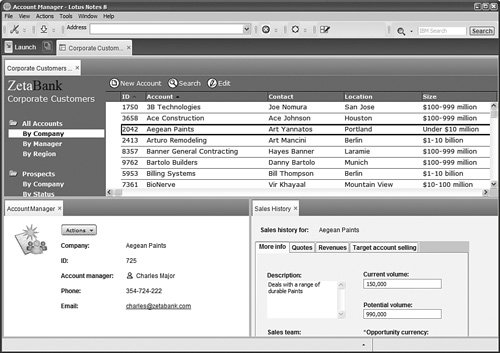What Is a Composite Application?
Most users require access to multiple applications in order to achieve their business objectives. Until recently, sequentially accessing applications to complete a business process has been the norm. Now, however, there is a better way. A new breed of applicationthe composite applicationenables individual applications to work together in ways that support business objectives.
Figure B.1 illustrates what a typical composite application might look like. Here a Lotus Notes Corporate Customer application is "wired" to an Account Manager application that accesses data from a Web server as a well as a Sales History application that surfaces information from the company ERP system.
Figure B.1. Composite application accessed through Lotus Notes 8[2]

Selecting an alternate customer in the Corporate Customer component forces the other application components to update and display documents that correspond to the newly selected customer. In essence, components in this composite communicate with each other based on user input. The net result is a more holistic approach to the business process of managing a customer base.
To make the assembly of this new breed of business applications easy, IBM has included composite application features in Lotus Notes and Domino 8. A number of business capabilities, surfaced as "components," can be brought together in one visual composition. These components are wired together so that information and data can flow between the components and run within an environment that defines and captures the business context.
This approach is unique because it not only combines the business components but does so with respect to user identity, business context, and the users role with respect to that business context.
Benefits for Lotus Notes and Domino Customers
Productivity of workers is a top concern among all businesses today. Lotus Notes and Domino has been instrumental in defining the concepts of collaborative applications that drive improved productivity in teams of people. This capability is further enhanced with the introduction of composite applications. With composite applications, IT organizations are able to quickly capture and reuse (as components) the investments they have already made in Lotus Notes and Domino applications. In addition, the composite application framework is based on open standards, making it possible to integrate Lotus Notes and Domino applications with other line-of-business or enterprise applications systems (SAP, PeopleSoft, and so on). The ability to capture existing applications as components and to combine and recombine their capabilities means that composite applications can now directly target specific business challenges in a way that is much more effective than any "off the shelf" software solution.
Benefits for Lotus Notes and Domino Programmers
Getting started with composite applications will be quite natural for IBM Lotus Domino developers. Using what they already know about building Lotus Domino applications, developers can create composites that exhibit synergistic behavior and add important value to their organization.
New attributes have been added to form fields and to view columns in Lotus Domino Designer. These attributes allow data from one Lotus Notes application to be exposed to the interconnection mechanism called "property broker." In addition, you can define "actions" with arguments (like lookup customer) that expose the operations of the component. By wiring exposed data elements of one application to the actions of another application, the Lotus Domino application designer can create comprehensive business applications from a multiplicity of Domino databases.
